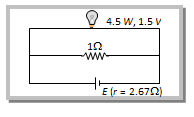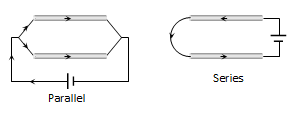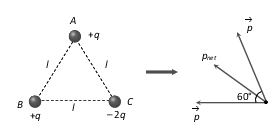11th And 12th > Physics
ELECTRIC POTENTIAL ENERGY POTENTIAL AND DIPOLES MCQs
Total Questions : 30
| Page 1 of 3 pages
Answer: Option C. ->
27 J
:
C
For pair of charge U=14πϵ0[10×10−6×10×10−610100+10×10−6×10×10−610100+10×10−6×10×10−610100]
=3×9×109×100×10−12×10010=27 J
:
C
For pair of charge U=14πϵ0[10×10−6×10×10−610100+10×10−6×10×10−610100+10×10−6×10×10−610100]
=3×9×109×100×10−12×10010=27 J
Answer: Option A. ->
64 J
:
A
Potential at the centre of square
V=4×(9×109×50×10−6√2)=90√2×104 V
Work done in bringing a charge (q = 50 μC) from ∞ to centre (O) of the square is
W=q(V0−V∞)=qV0
⇒W=50×10−6×90√2×104=64 J
:
A
Potential at the centre of square
V=4×(9×109×50×10−6√2)=90√2×104 V
Work done in bringing a charge (q = 50 μC) from ∞ to centre (O) of the square is
W=q(V0−V∞)=qV0
⇒W=50×10−6×90√2×104=64 J
Answer: Option C. ->
Surface charge density on the 15 cm sphere will be greater than that on the 20 cm sphere
:
C
After redistribution, charges on them will be different, but they will acquire common potential
i.e. kQ1r1=kQ2r2⇒Q1Q2=r1r2
As σ=Q4πr2⇒σ1σ2=Q1Q2×r22r21⇒σ∝1r
i.e. surface charge density on smaller sphere will be more.
:
C
After redistribution, charges on them will be different, but they will acquire common potential
i.e. kQ1r1=kQ2r2⇒Q1Q2=r1r2
As σ=Q4πr2⇒σ1σ2=Q1Q2×r22r21⇒σ∝1r
i.e. surface charge density on smaller sphere will be more.
Answer: Option C. ->
7.68×10−29 Coulomb×m
:
C
Dipole moment p = q (d)
=3.2×10−19×(2.4×10−10)=7.68×10−29C−m
:
C
Dipole moment p = q (d)
=3.2×10−19×(2.4×10−10)=7.68×10−29C−m
Answer: Option B. ->
1.6×10−29
:
B
p=q×(d)=1.6×10−19×10−10=1.6×10−29 C−m
:
B
p=q×(d)=1.6×10−19×10−10=1.6×10−29 C−m
Answer: Option B. ->
3.2×10−18J
:
B
K.E.=q0(VA−VB)=1.6×10−19(70−50)=3.2×10−18J
:
B
K.E.=q0(VA−VB)=1.6×10−19(70−50)=3.2×10−18J
Answer: Option A. ->
0.006 J
:
A
W=U2−U1=14πϵ0q1q2[1r2−1r1]=9×109×10−12[11−13]=9×23×10−3W=0.006J
:
A
W=U2−U1=14πϵ0q1q2[1r2−1r1]=9×109×10−12[11−13]=9×23×10−3W=0.006J



















